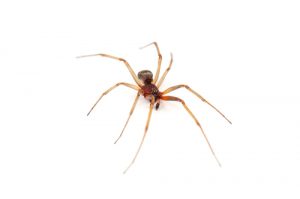Too Many House Spiders!
By Chris Williams on November 23, 2011.
Q. I have a lot of these same spiders in my house. They’re roundish and light brown and their webs are all over. I keep destroying the webs that I can reach but it seems like they’re back in no time. Do you know what kind of spider this is?
A. I’m guessing that it’s the American house spider, just because it is our most common indoor spider. This spider hangs upside down in its irregular, tangled cobweb waiting for insect prey. Webs are found near windows (especially behind draperies), and in corners of rooms either high or low, under furniture, and in closets, among other places. The number of webs in your home are not a real indication of the number of spiders though because the American house spider is known for abandoning unproductive webs and starting new ones. It prefers damp indoor areas like basements and crawl spaces.
 The American house spider has a globular, smooth body that is about 1/3-inch long and is dirty white with white to gray-brown mottled markings. This spider is similar in shape to the black widow but it does not have a poisonous bite. Often the web will also contain light brown, pear-shaped egg sacs.
The American house spider has a globular, smooth body that is about 1/3-inch long and is dirty white with white to gray-brown mottled markings. This spider is similar in shape to the black widow but it does not have a poisonous bite. Often the web will also contain light brown, pear-shaped egg sacs.
Not only are spider webs a nuisance and a mess, but web spiders are notorious for leaving grayish-white fecal droppings on surfaces beneath their webs. If you see mottled blotches on a surface, especially under furniture, it’s a good bet that there is a spider web somewhere above. Spider fecal spots are difficult to remove. Removing webs is not always easy either but vacuuming webs and egg sacs is one of the best ways to control spiders. Vacuuming also helps remove the spiders’ prey. One good way to remove webs from high-up or hard-to-reach areas is to use a specialized web duster with a telescoping handle.
The key to solving your spider problem is this: Spiders are only found in large numbers if there is an abundance of prey. Every home has a few spiders but if you always have lots, your home must also have insects or other arthropods that are feeding these spiders. Spiders aren’t picky about what they eat. Typical spider food includes cockroaches, fungus gnats, carpet beetles, crickets, Indian meal moths, even overwintering pests like Asian lady beetles or stink bugs. If you can keep other pests out, your spider population will drop or disappear.
You can keep other pests out by pest-proofing your home – sealing and screening openings that allow pests in, by reducing outside lights that attract pests, by clearing mulch, weeds, and debris that hide pests around your foundation, and with an insecticide treatment around the foundation to intercept invading pests. Call Colonial. We can get rid of your spiders and the pests they are feeding on. Pest-proofing is one of our specialties.